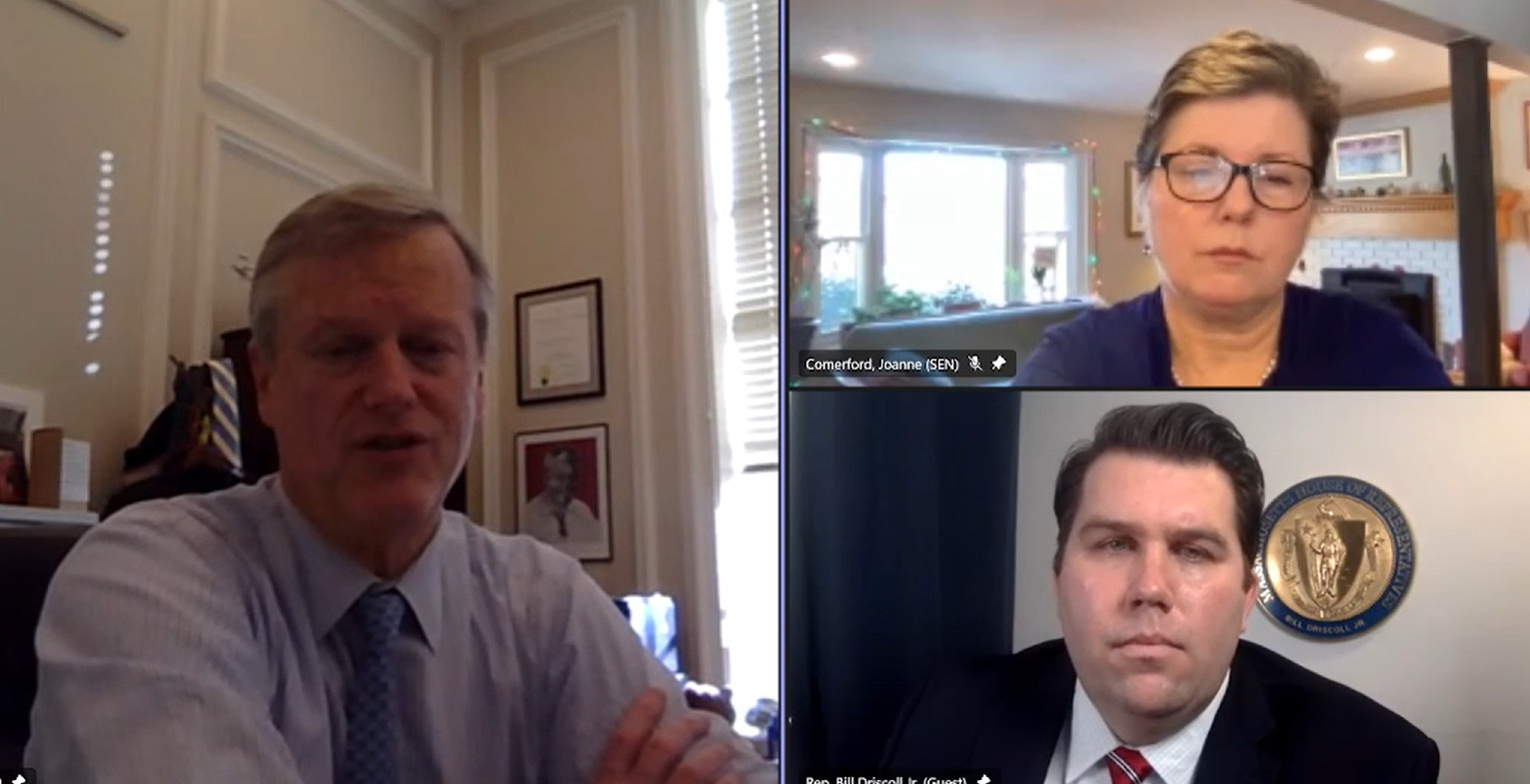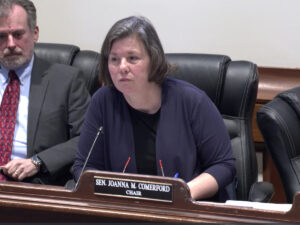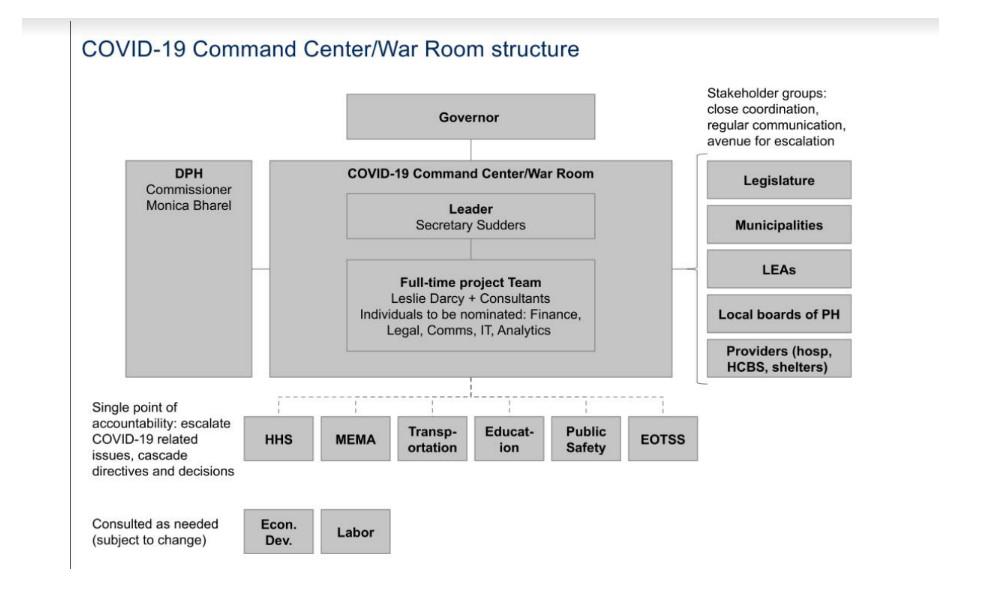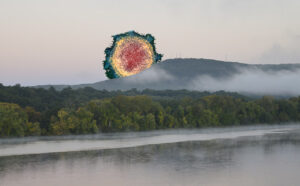Comerford Co-Led Committee Counsels COVID Corrections…

The Guv appearing at Comerford & Driscoll’s COVID Committee this past January. (via malegislature.gov)
Amid a breakdown in vaccine delivery, Massachusetts legislative leaders set up a joint committee to review the commonwealth’s coronavirus response. Its mandate extended the vaccine drive to review the pandemic response overall. Over 18 months, members, led by Northampton Senator Jo Comerford and Milton Rep Bill Driscoll, Jr., mined local and state officials for data, feedback and experiences.
This past week the committee presented its report on how the commonwealth must evolve from this ongoing, on some level, ordeal. Despite heated with Governor Charlie Baker and his Secretary of Health & Human Services, Marylou Sudders, the authors have been quick to note that the report is forward-looking.
“It’s our job to grow stronger form this and to learn the lessons from the pandemic,” Comerford said in an interview. “But then we also have to look to the future and really begin to internalize and articulate those long-term lessons.”
“I am grateful to all who shared their experiences and expertise before the Committee,” Driscoll said in a statement accompanying the report. “This report focuses on recommendations for the near-term that are important as the Commonwealth navigates the ongoing pandemic and builds readiness to contend with future emergencies.”
Because of the nature of the pandemic, particularly how infection flowed west from China into Europe and then the United States, Massachusetts was hit comparably early. While not seeded as severely as New York, Boston, as an international hub, became an epicenter, too. By the time Comerford, also co-chairs of the Joint Committee on Public Health, held an early March coronavirus hearing, the Biogen Conference at the Long Wharf had already happened, sparking its own global chains of transmission.

Sen. Comerford at a March 2020 just before the shroud of the coronavirus fell… (still via malegisalture.gov)
Massachusetts, and much of southern New England, seeded abroad and from New York, got hit hard. Per capital hospitalizations and deaths would be among the nation’s highest until vaccine refuseniks fueled destruction elsewhere in the US. The committee report’s tone acknowledged this, focusing on surveillance within the state’s control, utilization of existing health resources and structures, and vaccine distribution.
It was the well-publicized breakdowns in vaccine distribution that prompted the legislature set up the committee. Comerford, a social worker by training, feted the panel’s work as a team effort. She took pains to share credit with her co-chair, who has a background in disaster management.
Over several hearings, Comerford and Driscoll and their colleagues grilled Baker administration officials, including his Excellency himself and Sudders. Even through the limited portal of remote hearings, the tension and frustration leapt through the screen. Yet, Comerford said that communication and cooperation remained with the administration.
“There is no blame in this report,” the Northampton Democrat told WMP&I a few days after the report’s release.
EOHHS did not provide comment on the COVID-19 and Emergency Preparedness Committee’s report. A spokesperson for the governor did not respond to a request for comment.
The Committee also held regional hearings, to obtain testimony and details from officials from across the commonwealth.
Countering the coronavirus was a “herculean” effort, she said, but with the benefit of hindsight, improvements in resource distribution and command structure become apparent. The report also looked at managing the lingering elements of the pandemic in Massachusetts. Comerford also pointed out that the legislature has made millions available to improve, expand and synchronize local public health. Yet, there would likely be more work ahead for her Public Health Committee.
The report notes the legislatures has authorized $200 million over five years for this purpose. The recommendation goes further, though calling for further build-out and support for local departments. Comerford said there was a broad spectrum of success and execution among cities and towns’ 351 boards of health. The report also urges better support for local contact tracing during disease outbreaks—not just COVID-19—and better sourcing of supplies and testing materials.
Moreover, the report is critical of the state’s failure to utilize regional Health and Medical Coordinating Coalitions (HMCC). They require more autonomy and less bureaucracy to better assist localities, especially as they differ from the entire state.
The report also pans the Baker administration’s failure to use an orthodox command structure to manage the response. Authority was unclear except that Sudders sat atop the whole apparatus.

The commonwealth’s response deviated from nationally accepted incident standards. (via malegislature.gov)
“The administration deviated from standard incident management practices with the COVID-19 Command Center as the primary response operations structure responsible for multi-agency, multi-discipline and all jurisdictional coordination. The COVID-19 Command Center, the core of the administration’s response to the virus, used a more amorphous, less defined structure, placing EOHHS Secretary Sudders at the helm of its operation,” the report reads.
This “hub & spoke” setup also left local officials to enforce changes and rules, often with little opportunity to offer input. Rather, a clearer line of command should have run through the Department of Public Health, which reports to Sudders.
The Committee identified similar problems with the vaccine rollout. Indeed, a separate recommendation called for the appointment of a special assistant for vaccination to oversee allocation and administration of vaccinations.
Comerford observed that communities of color and rural populations remain some of the least vaccinated in the state. These are the same communities that now lack full vaccination courses, something that remains a problem as vaccination expands to children as young as six months.
“To the Baker administration’s credit, they did these equity communities” during earlier phases of the vaccine campaign, Comerford said. However, she said there should be somebody establishing and meting out benchmarks in the vaccination space.
“The person in this role must be expert not simply in vaccines and infectious disease, but must be someone with a proven track record of trust within communities of color and must be committed to developing direct lines of communication with community-based organizations,” the report states.

Even if COVID sunsets, the commonwealth can apply lessons to well beyond the Coronarivus. (created via wikipedia images)
Many efforts to manage Sars-CoV-2, the virus that causes COVID-19, will likely last only as long as the pandemic does. Others could endure and apply elsewhere with longer-term impacts.
The report urges investment in wastewater surveillance. Currently, this data can predict peaks and valleys in coronavirus spread. However, as symptomatic Covid and testing ebbs, the examination of sewage could offer hints into other epidemics. Right now, however, some parts of Massachusetts are surveilling their effluvia better than others.
“Wastewater is an emergent technology,” Comerford said. “Something that is going to benefit is way beyond COVID.”
In addition to this virus, it could be signal rises in mosquito-borne disease or even spikes in opioid use.
This committee arose amid a broader context of greater legislative oversight on Beacon Hill. For example, the Transportation Committee will soon probe the administration’s management of the Massachusetts Bay Transportation Authority. Comerford emphasized this was a proper role for the legislature in a crisis. However the committee was just one part of the larger whole.
“That’s the thing. This was not done from the sidelines,” she said. “We have a responsibility here in partnership” with the administration.
“I’m not telling you that I got every one of those oversight hearings right, but would I do them again? Absolutely,” Comerford added.